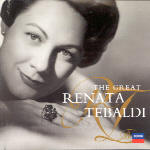This is a remarkable collection, covering studio recordings made between 1949 and 1969, which is to say from roughly the beginning to the end of Renata Tebaldi’s illustrious career. It’s a pity Decca didn’t choose to present the selections chronologically; this is a grand study for voice students. Early on, the top notes are easy (Tebaldi never was a high-note star), and both “Ritorna vincitor” and “Tacea la notte”, from 1949, benefit greatly from this ease. Indeed, the Trovatore Leonora soon left her repertoire, probably because it sits so high. The Forza and Manon Lescaut arias from the mid-’50s are similarly easy on top, and furthermore, her involvement, artistry, and mid-voice are more impressive.
Little by little you notice a slight strain entering the notes above the staff, but at the same time, a greater richness elsewhere in the voice compensates for the loss. In the ’60s the voice darkens considerably, and in excerpts from Don Carlo and Il tabarro, we get to hear Tebaldi in dramatic context (rather than arias) and we can judge how she became more of a singing actress. But what is most impressive is the way in which Tebaldi didn’t change: the voice retained its luster over the 20 year span and the sense of legato and musicality remained intact.
This is a tribute to Tebaldi’s intelligence as an artist and to her solid technique–top notes come and go, great sopranos last for a long time. Of course this is not uniformly perfect singing, and her dramatic insights were outclassed by others; but this is still highly recommended. Luscious singing like this is in short supply today. No texts or translations are included–keep saving those pennies and go right on discouraging new customers, record companies! [3/15/2002]
































